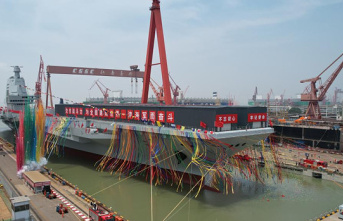After two postponements due to the recent confinement of Shanghai by Covid, China's third aircraft carrier, baptized 'Fujian' in honor of the coastal province off the island of Taiwan, claimed by Beijing, was launched this Friday. It does not seem that the name is accidental because the waters of said strait, which is 180 kilometers long, will be the ones that this new ship sails, whose entry into service will still take a few years. Amid growing maritime tensions with the United States in the Pacific, aggravated by the Russian invasion of Ukraine, the Chinese regime confirms its rise as a military superpower and continues to advance towards its goal of having six aircraft carriers by 2035, the next nuclear-powered.
With 80,000 tons and a totally own design, the 'Fujian' is the most sophisticated of the three aircraft carriers that China already has. With a cover that does not end in a ramp like the previous two, it incorporates innovative electromagnetic catapults to propel the takeoff of its fighters.
Such a system, which improves on-board operations, demonstrates China's military and technological progress because, until now, only the US had it on its Gerald Ford-class ships. "This is the first aircraft carrier with these catapults entirely designed and built by China," state television CCTV proudly announced, indicating that the first mission of the ship will be "to sail and do mooring tests after launching."
Since President Xi Jinping took power in 2012-2013, he has pushed for the modernization of the People's Liberation Army to support China's rise as a superpower and its expansion across the Pacific. With numerous territorial disputes with all its neighbors, from Japan to the South China Sea, the main claim of the authoritarian regime in Beijing is Taiwan, the "de facto" democratic and independent island whose sovereignty it claims.
In recent times, the Chinese Army has increased its air raids on the island in what appear to be rehearsals of a hypothetical invasion. Last week, during the Shangri-La Dialogue Forum in Singapore, Chinese Defense Minister Wei Fenghe again warned the US, Taiwan's main ally and arms supplier, that "it would not hesitate to start a war, no matter what the cost," if the island formally declares its independence. This area is one of the hottest on the planet because both US and Taiwan Intelligence fear that China will attempt an invasion by 2030. But they are still trying to guess whether Putin's failure in the war in Ukraine and the unity it has brought about in the West may dissuade Xi Jinping, the most authoritarian leader since Mao, from his dream of reunifying the island.
To do this, not only will it remain in power at the 20th Congress of the Communist Party of China, scheduled for this fall, but it will continue to promote its Army and widen its ideological differences with Western democracies. In the first aspect, the recent security agreement signed with the Solomon Islands stands out, which could open the door to a Chinese naval base in the Pacific, and, in the second, its support for Russia in the war in Ukraine.
With this new aircraft carrier, Beijing also intends to deal with the US military presence in the Pacific and the main world shipping routes, as well as the agreement signed between Washington and London to provide Australia with nuclear technology for its submarines. In 2012, the regime launched its first aircraft carrier, the 'Liaoning', an unfinished 300-meter-long Soviet vessel bought from Ukraine in 1998 and originally intended to be a floating casino in Macau. With the same design and its rising ramp deck, in 2019 it put into service its second aircraft carrier, the 'Shandong', reinforcing its naval presence in Asia. After the qualitative leap that it has now given with the 'Fujian', its next objective is to continue increasing its navy, the largest in the world but still based on small ships, until it is equipped with nuclear aircraft carriers in the coming years.












